The availability of information technologies and a noticeable change in attitudes towards their presence in everyday life gave impetus to the development of the concept of the Internet of Things. Over the past ten years, IoT has managed to penetrate almost all spheres, shifting to “smart” devices the care of human comfort and safety, the performance of monotonous or dangerous work for it, and form with it a common information space.

In the comfort zone
Despite all the controversies, and sometimes even the unfounded fears about the all-pervasive IoT, the latter was invented in order to make life easier and more convenient. Of course, its capabilities are not limited to this, but, nevertheless, most of the “smart” devices that are well-received and already tested by consumers relate to functional comfort in everyday life and people’s work. The interaction between different IoT devices increases their utility ratio, and the information obtained from them is already perceived by all as a completely natural phenomenon of modern life and does not cause internal rejection.
Today, consumers have to put up and gradually get used to the fact that most manufacturers have begun to actively implement IoT-technologies in home appliances and other products, whether they like it or not. For example, it is already difficult to find a TV in the store that would not have the ability to connect to the network. In fact, this has already become a standard function for these devices, which in the near future will be massively introduced by manufacturers of refrigerators, teapots, washing machines, etc.

The most famous and widely used IoT-solution for home comfort has become a "smart home". With its help, it became possible to remotely control a dwelling: turn on / off various electrical appliances and lighting, control children and animals through a video camera and a smartphone, set appropriate temperature parameters and much more.
In terms of functional comfort, the Internet of Things is not only effective for home use. The “comfortable” IoT solutions can also include special sensors and wearable devices that allow you to monitor a person’s physical condition, make purchases and payments online, park and warm cars. GPS systems, RFID tags, ATMs, POS terminals, and a bunch of objects connected to the network and working on a person create around it a zone of functional comfort and simplify life.
Routine - cars!
In addition to comfort, the Internet of Things provides an opportunity to shift labor-intensive, repetitive, and dangerous or harmful processes in various fields onto the shoulders of machines and devices.

"Smart" devices freed a person from routine work. Now they automatically, in any weather, control industrial conveyors, condition and movement of goods, regulate movement and monitor the ecological situation in the city, and do a lot of useful things all day and night, without days off and holidays. Automation of standard processes using IoT devices is actively used today in industry, utilities, agriculture, medicine and transport, minimizing the human factor and its inherent risks.
A good example of changing the model of work with the help of IoT is wireless automated dispatching in the utilities sector. Meters with Internet access send readings to the dispatcher via the “cloud”, which makes it possible to have data on a separate apartment, house, or city as a whole. Public utilities, without entering the premises, can remotely control metering devices and issue invoices. Such a system removes the problem of detours and saves financial and time resources.
In the agro-industrial complex, automatic irrigation systems, soil condition monitoring and planting systems have proven themselves well. The sensors assigned to individual areas or even plants generate around-the-clock information to a cloud server, which, after processing, transmits data to the operator about the state of the field and the need for certain measures.

With the help of special solutions based on IoT, it became possible not only to monitor the degree of turbine wear on offshore wind turbines, but also to monitor their performance. This allows not to send specialists to remote offshore platforms for preventive maintenance. The introduction of one of the Swiss companies specializing in the production of electric motors and machine tools, IoT-technology for proactive maintenance, allowed the companies operating them to conduct online tracking and prevent sudden breakdowns.
Of course, these are only the most well-known examples, and the mass automation of everything and everything based on the Internet of Things is still far, and not always advisable. In this direction, the use of "smart" devices is hampered by a number of problems, most of which are related to the low speed and latency of data transmission to the server, insufficient security of networks and the devices themselves. However, optimism suggests that the solution to these and other problems is in an active stage.
Safe world
Every day a huge number of "smart" and, at the same time, potentially vulnerable devices are connected to the Network. The data that IoT devices collect is valuable for intruders, and the network infrastructure itself may be destroyed or damaged as a result of a hacker attack. Therefore, the issues of preserving financial, personal and any other data and cybersecurity in general are equally important for the government and business, as well as for an individual user.

Despite fair criticism regarding the weak security of the smart devices themselves, ensuring data security and integrity is an integral part of the IoT ecosystem.
Security measures that ensure the operation of IoT devices are applied in four directions:
connection ,
identification ,
data encryption ,
application security . As a rule, these measures are implemented individually by each device and software manufacturer. Basically, IoT protection systems are aimed at detecting and preventing data leakage. They are also used to prevent unauthorized entry by unauthorized persons into the system in order to steal information, which in some cases may be much more dangerous than taking control of the device.
At the same time, the IoT devices themselves are part of a security system. All kinds of home / apartment security systems and warnings about undesirable events such as infiltration, leaks, smoke, etc. have become widespread today. Children's smart watches allow not only to monitor the child’s location through the parent “cell phone”, but also to maintain voice communication with it, to transmit alarm signals when trying to remove a device or exit a certain zone.
Systems of "mass" security, using "smart" devices, have proven themselves in places of large concentrations of people.

With their help, recognition of passengers' faces is carried out in almost all major airports of the world. Special cameras scan the faces and irises of the eyes and transfer them to the database. Thanks to this, it is possible to track the movement of dangerous criminals and terrorists.
The European Commission has begun funding the
MONICA project, which aims to develop a security complex to protect people in their crowded areas (concerts, amusement parks, rallies, etc.). Part of the security system will be "smart" devices - chest cameras, bracelets, UAVs, GPS systems and RFID tags.
Thus, the Internet of Things, despite the existing problems with its own protection, has long been closely involved in the global security system. At the same time, the task of developers of various solutions for IoT is also to ensure that the improvement and refinement of “old” security systems do not lead to the emergence of new vulnerabilities.
Information Environment of the Future
The development of IoT-technologies is accompanied by an increase in the volume of information storage, and this process occurs constantly. Very soon there will be networks consisting of tens of billions of devices exchanging data with each other.

This will lead to the interweaving of the physical world with the digital. As a result, an absolutely new environment is formed around us, where “smart” devices through special applications will analyze everything that happens in the physical world, take into account accumulated experience and make the necessary decisions according to their functionality. This environment will create completely new conditions for all spheres of human activity, ranging from everyday life and ending with complex production.
The new information environment will change not only the “smart” people and not the people around and the processes in which they are present, but also himself, transforming him into some kind of device manager. Therefore, today the Internet of Things should be considered in synergy with other modern concepts, for example, the intellectual environment or all-penetrating computer systems.
Modern technologies and modernization of wireless networks will be able to ensure the massive introduction of IoT, it remains to solve some problems of protocol compatibility and security. But one should not discount the factual unpreparedness of the majority of people for cardinal innovations in the application of their usual things, which have suddenly become “smarter”. On the example of the same mobile phones, one can see the gap between human habits and the development of technology.

Thus, for large-scale changes in people's minds to occur, technology alone is not enough, and this applies not only to the Internet of Things. We need constant awareness, legal regulation, social adaptation to the new realities of life. Only then will any new technology be in demand and reach the level for which it was created.